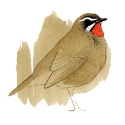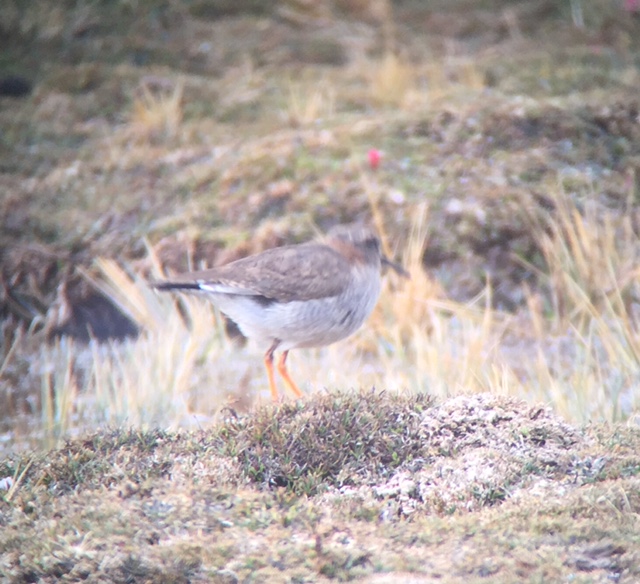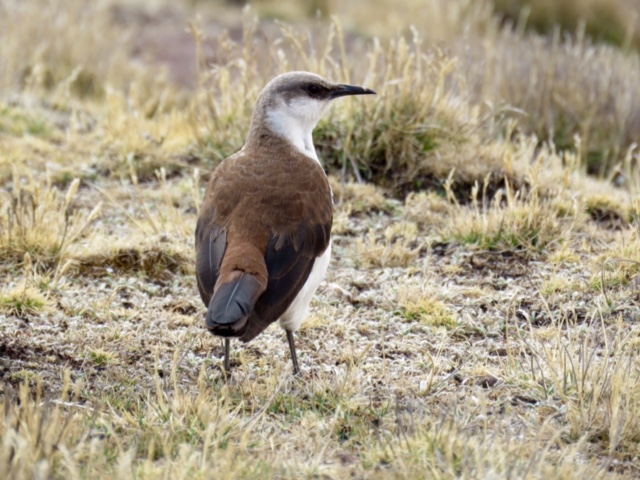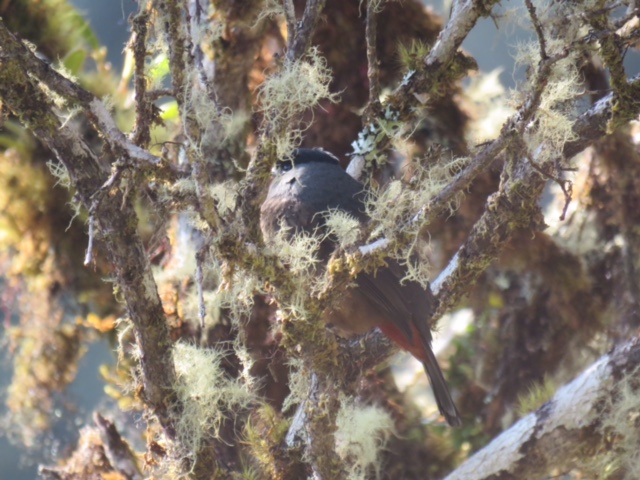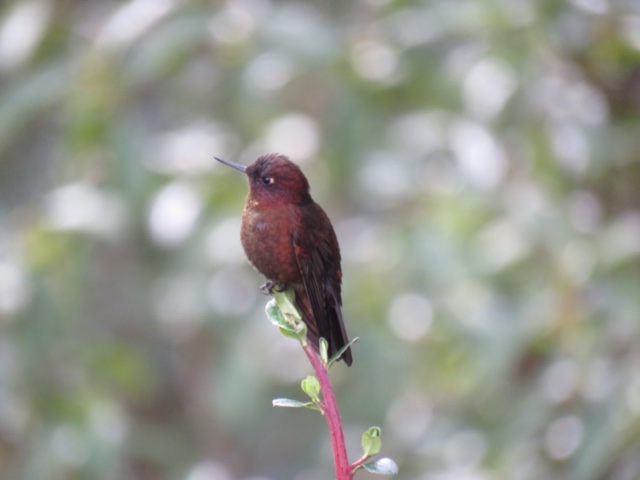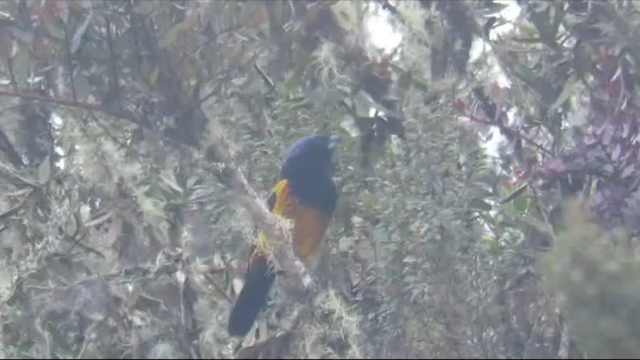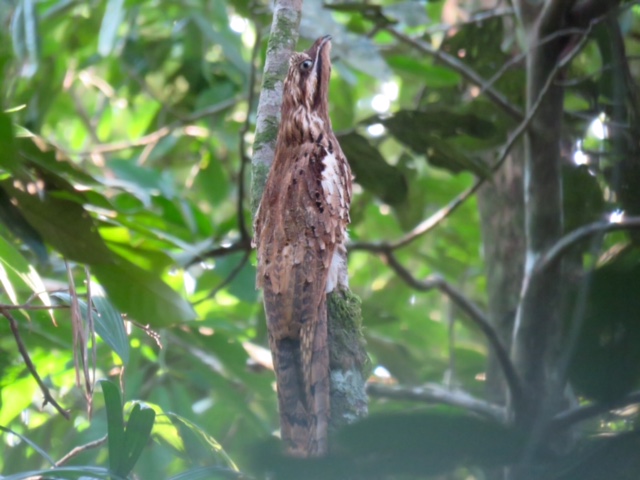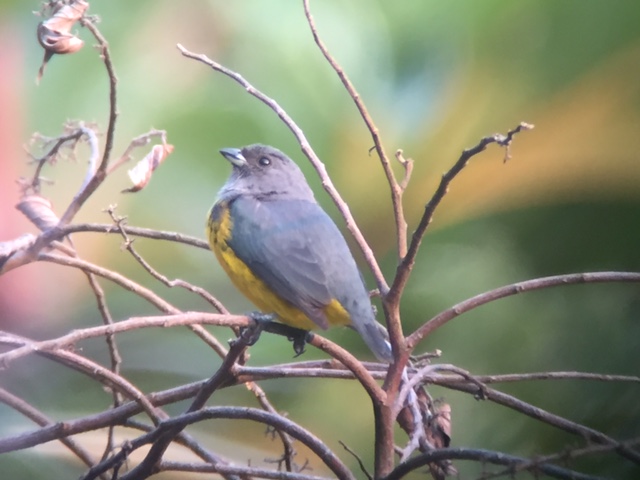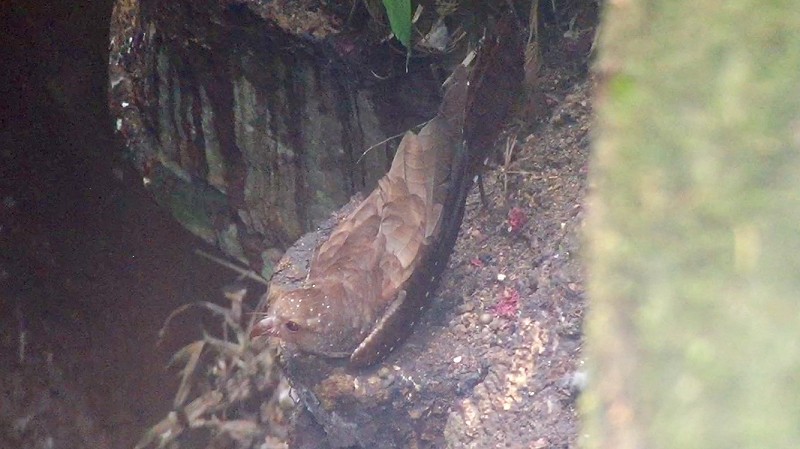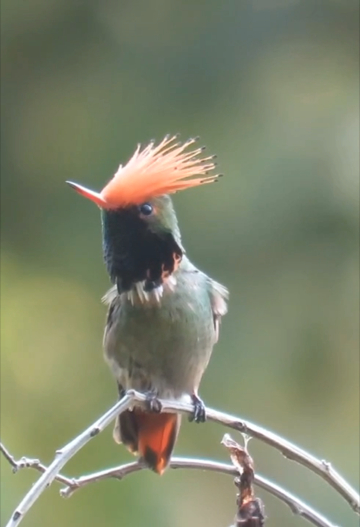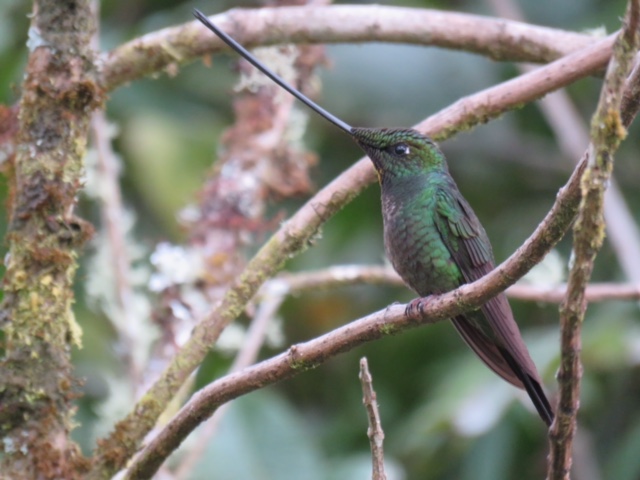PLEASE MAKE A DONATION NOW!
world.observation.org/arjan
www.arjandwarshuis.com/#biggestyear
September 8th MISSION IMPOSSIBLE
Miguel had something outrageous in mind, to do the Santa Eulalia Valley and Marcapomacocha in a single day and still make it in time to Junin to spend the night there. This would mean that we had to drive up from sea-level (Wim’s house) to 4800 meters (Marcapomacocha). The last time I did something similar I was vomiting and simultaneously crying while being dragged by my friend Vincent to a scope to see a Diademed Plover :). I guess you can say I’m quit subjective to altitude sickness. Luckily Camilla has altitude sickness pills with her so I hoped for the best…
Our first target right after sunrise was the Great Inca-finch, but after half an hour of searching we had to give up and drive up to try for one of the trickiest birds today, the endangered Rufous-breasted Warbling-finch. We tried for two hours along the famous stretch of road where the bird is sometimes recorded, but had no success. I had already given up by 10 AM, but Miguel kept pushing, we had to find this bird! Suddenly I heard a whistle, Miguel had found the bird! I took a sprint, but when I arrived the bird was gone. It took us another half an hour before I finally re-found the bird. Awesome, but we had lost a lot of time… We raced down to try for the Inca-finch once more and this time we found the bird within a minute, we were back on track!
Next came an even trickier bird, the White-cheeked Cotinga. This bird is already very difficult in the early morning let alone in the heat of midday. Against all odds we climbed the Polylepis covered hillside, but after an hour or so with zero activity we had to give this bird up, otherwise we would never make it in time to Marcapomacocha. While we had lunch down below at the roadside Miguel suddenly jumped up and screamed ‘Cotinga’! I couldn’t believe my eyes, but there was a pair of White-cheeked Cotingas perched on top of a Polylepis bush! Yes!
We were now on schedule to do the impossible. We drove up to Marcapomacocha and with two altitude-sickness pills, two aspirins and a lot of water I seemed to be doing fine, as did Camilla! We arrived at a bog at 4800 meters. The only place in the world to see the critically endangered White-bellied Cinclodes, a beautiful bird that has suffered most from mining activities in the area. Its population is thought to number less than 200 birds, but it could be even less.
Luckily for us these amazing snowy-white birds were readily found and next came a spectacle that will stay in my mind forever. A group of three birds approached us and started feeding and displaying less than five meters away! An out-of-this-world sighting…
We finished this already amazing day in style with a Diademed Plover, my second this year, but an incredible bird nevertheless!
September 9th THE SHORES OF LAGO JUNIN
We started our day by trying to see the critically endangered Junin Grebe from a lookout point overlooking Lake Junin. Both Miguel and I knew this would be impossible, but we had to give it a try. Ten years ago I did the same, but back then it was impossible to say anything about bill length or head shape - the only way to separate it from the far more common and very similar Silvery Grebe – since the birds were almost a kilometre away (the Junin Grebe does never venture into the shallows and always stays in the deep water after the furthest reed beds). So ten years ago we hired a small boat and spend half the day looking for the grebe in the deep part of the lake, a fun adventure with huge success! This time I didn’t have the time or the money so in my mind I had already dismissed the possibility of seeing the grebe again. Anyways we tried and with 60 x magnification I scanned through flocks of coots and grebes in the far distance. Conclusion, no chance in hell :). We couldn’t even see the bill of any of these birds let alone say anything about length and shape. We quickly picked up the endemic Black-breasted Hillstar and headed north to Hunanaco. En route we stopped in a dry valley where we saw our second species of Inca-finch this trip, the Rufous-backed Inca-finch.
We arrived in Huanaco around 4 PM and with 2 hours to kill Miguel opted to already drive up to Bosque Unchog and camp there, so that we would be in Golden-backed Mountain-tanager country at first light the next day.
We arrived just before dusk, set up tent, enjoyed dinner prepared by Miguel and Juve on the stove and tucked in for a freezing cold night...
September 10th LIFE BEFORE SEEING THE GOLDEN-BACKED MOUNTAIN-TANAGER
Ten years ago Vincent van der Spek, Jelmer Poelstra and I spent a full day in cold, wet and generally miserable weather looking for the Golden-backed Mountain-tanager at Bosque Unchog. Back then we had to leave the mountain empty handed, a dip that haunted all three of us for quite some time. So today I got the chance to finally redeem myself.
At 5:30 AM I couldn’t hold myself much longer – it was bloody cold anyhow – so I stepped out of our tent and started chasing some sounds. Undulated Antpitta, Neblina- and Tschudi’s Tapaculo and Many-striped Canastero were all heard, but I only managed to see the latter.
We had breakfast and braced ourselves for the Mountain-tanager quest. As we walked past the first elfin forest patches towards the gorge where the Unchog Big 4 – Golden-backed Mountain-tanager, Rufous-browed Hemispingus, Bay-vented Cotinga and Pardusco – are most regularly reported, we picked up Tschudi’s Tapaculo, White-chinned Thistletail and the endemic Coppery Metaltail. Best was a flyby White-throated Hawk.
The first of the big 4 and a bird I’d missed last time was a fantastic pair of Bay-vented Cotinga picked up by Miguel on call, a good start! Then things quickly slowed down and by 11 AM we had only found Pardusco and Taczanowski’s Chat-tyrant.
By 2 PM I was getting desperate and knew that I would probably dip the Tanager for the second time in my life. By 4 PM I had given up. Mentally and physically broken Miguel and I started to walk back to the car where Juve and Camilla where waiting (they’d walked back a little earlier to break up camp). Along the way we flushed a very welcome Andean Snipe.
Then is happened… At the very last elfin forest patch I picked up on a movement in a tree. I aimed my binoculars and saw something large and bright yellow. GOLDEN-BACKED MOUNTAIN-TANAGER!!! 3 Birds together! I couldn’t believe my eyes. Miguel and I were dancing on the trail and quickly called Camilla on the walky-talky. I saw Camilla approaching in the distance, but the birds started to move… Would she make it in time?? Yes! In the nick of time, completely out of breath Camilla got one very good look of all three Mountain-tanagers before they vanished over the ridge. Mission accomplished!
September 11th LIFE AFTER SEEING THE GOLDEN-BACKED MOUNTAIN-TANAGER
When I woke up today I was still thinking about that awesome Mountain-tanager from yesterday, what an amazing bird! Anyways, back to business…
We started our day above the famous Carpish Tunnel where we tried for two endemic antpittas, Bay Antpitta and Chestnut Antpitta. Upon arrival it was a sad sight that most of the once pristine cloud forest had been cleared to make way for Hortensia plantations. To me it is unbelievable that beautiful rainforest is cleared so that people can have some colourful flowers in their living room. Since the forest around this area is completely unprotected it won’t take long before all the hillsides are covered with these plantations. While we were there the whole valley was covered in smoke caused by set fires to clear the forest. Ironically the ‘clouds’ of the cloud forest have been replaced by smoke.
Luckily we managed to track down the two endemic Antpittas, the endemic Large-footed Tapaculo and Peruvian Wren in the remaining forest patches above the tunnel. I was especially pleased with an extremely cool Buff-tailed Sicklebill feeding on some flowers next to the track and a stunning pair of Streak-headed Antbirds.
The Paty Trail is also loosing its once legendary birding status due to deforestation in the area. Still we gave it a go to look for the endemic Peruvian Tyrannulet which luckily proved not too difficult. Other nice finds were Flame-faced Tanager and Rufous-winged Barbtail.
By midday we started heading north towards Tarapoto, a long drive that would take us two half days.
September 12th A PIMP-ASS POTOO
After spending the night in Tocache – a town half way between Huanaco and Tarapoto – we hit the road again. Around midday we hit a roadblock caused by a strike. Considering the fact that these roadblocks can last for over 24 hours we were lucky that the road opened up after just half an hour of waiting. So around 2 PM we arrived at Aconabick, a community run private property famous for having some fantastic hummingbird feeders which attract the endemic Koepcke’s Hermit.
The feeders were indeed fantastic and within half an hour we recorded 15 species of hummingbird including Pale-tailed Barbthroat, Great-billed Hermit, Long-billed Starthroat, Rufous-breasted Hermit and of course several Koepcke’s Hermits. After we finally managed to drag Camilla away from the feeders we set foot on the trail system behind the property. Our big target here was a roosting Long-tailed Potoo which had been discovered here 1,5 years ago. The bird had been lost for a while, but luckily for us it was re-found just two months prior to our arrival.
After walking for 15 minutes or so we arrived at the spot where we immediately saw this amazing bird perched perfectly camouflaged on a branch inside the forest. What an incredible sighting!
From Aconabick we drove down to Tarapoto where we spent the night.
September 13th THE TUNNEL
Early morning we drove up from Tarapoto to the famous tunnel area, which lies at about 1200 meters altitude on an isolated ridge. This area holds some peculiar bird species with a poorly know and patchy distribution on similar ridges throughout the northern Amazon basin. Shortly after sunrise we found our first flock, which held several different species of Euphonia and since the very rare Plumbeous Euphonia has been recorded from this area Miguel played some tape. To our amazement we got a response. We quickly located the bird and for the next ten minutes we got ridiculous eye-level views of this mega rarity, which was the first lifer this trip for Miguel.
Other good birds this morning around the tunnel were Dotted Tanager, three Golden-collared Toucanets, Rose-fronted Parakeet and a stunning Black-and-white Hawk-eagle.
En Route to Moyabamba we made a quick stop in the peculiar dry forest around Juan Guera, a small village south of Tarapoto. Here we found the range restricted (Huallaga) Northern Slaty Antshrike and Sulphur-bellied Tyrant-manakin.
The most awesome sighting of the day was at a small bridge over a steep gorge from where we had fantastic scope-views of several dozens of Oilbirds – a monotypic species of nightbird that looks like a crossbreed between a nightjar and a hawk.
In the late afternoon we arrived at the wonderful Waqanki Lodge, which lies at the base of an islolated ridge with some very cool and very range restricted bird species, but these had to wait for tomorrow morning. We spent the afternoon at a leisurely pace around the hummingbird feeders where we saw a dazzling male Rufous-crested Coquette and several Black-throated Hermits. Other goodies around the premises were the newly described Varzea Thrush, the endemic Mishana Tyrannulet and the poorly known Sooty-headed Tyrannulet.
September 14th THE LONG-WHISKERED OWLET!
Another huge day which will be difficult to summarize in a few paragraphs, but I’ll give it a try :)
At 5 AM Miguel and I started walking up to the ridge high above Waqanki Lodge, which is currently the only place to find the endemic and endangered Ash-throated Antwren. Camilla decided to spend the morning at Waqanki so she could have some more time with all those amazing hummingbirds.
The three hour walk to the ridge is steep and quite tough, but along the way we managed to find some fantastic birds like Chestnut-throated Spinetail, Black-and-white Tody-tyrant, Tawny-throated Leaftosser and Red-billed Tyrannulet.
We arrived at the ridge around 9 AM, perfectly on schedule. Here we began our search for the Antwren. For half an hour or so we didn’t get any response, but luckily there was a splendid Broad-billed Motmot to keep me busy. Suddenly we heard the Antwren calling from further up the ridge and after some playback we got incredible views of this hard to find specialty.
We took another route down through dryer forest where we found our target – the Northern Chestnut-tailed Antbird without too much difficulty.
From Waqanki we started heading up towards Afluente, a small village at 1200 meters on the eastern slope below the famous Alto Mayo NP. En route we had lunch at a swamp near Moyabamba, where we found two very good birds, Pale-eyed Blackbird and Black-billed Seed-finch.
As we drove up towards Afluente dark clouds packed over the mountains, not a good sign as tonight we would try for the enigmatic Long-whiskered Owlet, one of my most-wanted birds for this whole year.
In the single hour of daylight we had left we found a big flock just above Afluente which held a nice selection of tanagers and the rare Ecuadorian Tyrannulet. Our main target at Afluente was the Ecuadorian Piedtail, an uncommon and range-restricted hummer which can often be tricky to find, until now! A young boy has started a small business with a couple of hummingbird feeders and these attract the Piedtail. So after five minutes of waiting we had the Piedtail plus bonus Green Hermit in the bag.
Our bird of the day – and possibly of the trip – had to be found after dusk, namely the Long-whiskered Owlet, but if it’s raining; no way… We first had dinner at the tiny settlement of Funda Alto Nieva - where we would also spend the night. Then it was time to begin our owlet-quest. By now a thunderstorm was well on its way and roaring thunder and lightning now and then lit up the forest like a Christmas tree. Not ideal conditions for finding a 13 cm, very rare owlet with a call like a frog. Anyway we gave it a go and I kept my fingers crossed as we set of into the elfin forest with a local guide. After 20 minutes of walking across a slippery track we arrived at the first spot. I held my breath as Miguel played the tape, but after 15 minutes there wasn’t a single response. We tried a next spot while the thunderstorm was approaching, I counted just 3 seconds between lighting and thunder… No response at the next spot. One more site to go, but would we still have time? It now started to rain lightly… Suddenly the Owlet responded! A soft but clearly recognisable ‘prrroow’. We chased the sound with our torches, but it had already moved. This went on for at least half an hour, but then ‘Bang!’ we got it in the torch beam! Unfortunately from the rear, but you could clearly see the whiskers pop out! Yes! Barely 5 minutes after this sighting it started pouring down heavily. We had been just in time, unbelievable! And I almost forgot, we also saw a fantastic Cinnamon Screech-owl. What a memorable day!
September 15th THE RARITIES OF THE STUNTED FOREST
After quite a cold night sleeping on a wooden mattress we had breakfast. It had rained heavily for most of the night, but as luck happens to be the rain had stopped and birds were singing!
Our first and my most wanted target of today was the endemic and endangered Ochre-fronted Antpitta. This species – along with Bar-winged Wood-wren, the Owlet, Cinnamon-breasted Tody-tyrant and Royal Sunangel – is only found in the peculiar stunted elfin-like forest in northern Peru. What makes this forest and the niche that these birds occupy so special is that it is elfin-type forest at just 1500 meters. Normally one would expect this type of forest above 3000 meters just below the treeline. Apparently the humidity and the relatively cold temperatures enabled this forest to develop in such a peculiar way.
We arrived at a bamboo and moss dominated spot in the forest and started playing the call of the Antpitta and after about 15 minutes we got a response. Slowly the bird got closer and we all tried to focus through the undergrowth to get a view. Suddenly the bird popped up and gave a brief but incredible view, but only for me unfortunately. The bird didn’t show a second time.
The Wood-wren and the Tody-tyrant were found fairly quickly so next we went to the hummingbird feeders to hopefully see the Royal Sunangel – which is far from guaranteed here. We had luck on our hands and after just ten minutes of waiting we got unbelievable views of a male Sunangel!
Next we went 300 meters downhill to look for some nice flocks, since we still needed a couple of birds from the lower altitudes. And we did find a flock, one of the best flocks I’d ever seen with Olivaceous Piha, Black-throated Toucanet, Scarlet-rumped Cacique, Blue-browed Tanager and a stunning male Vermillion Tanager, wow!
We spent the rest of the day slowly traveling and birding up towards the Owlet Lodge near Abra Patricia. We arrived at this amazing lodge with two hours to kill so we went on the trails. A great choice since we found a smashing male Lulu’s Tody-flycatcher.
We ended yet another fantastic day in style with a Sword-billed Hummingbird at the feeders and of course and owl, namely a beautiful White-throated Screech-owl!
Arjan Dwarshuis
PLEASE MAKE A DONATION NOW!
world.observation.org/arjan
www.arjandwarshuis.com/#biggestyear
